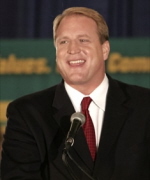Democrats on the Verge of Historic Collapse in Iowa Governor’s Race
Culver’s polling numbers on pace to produce biggest cycle-to-cycle decline in Iowa Democratic gubernatorial vote in state history

Iowa Democrats also knew they were going to have a difficult time retaining the governor’s mansion ever since former four-term GOP Governor Terry Branstad’s name was mentioned last year as a potential candidate against one-term Democratic incumbent Chet Culver.
Head-to-head matchup polling throughout 2010 has unanimously found Branstad with a lead outside the margin of error, with all but two polls spotting him a 15-point advantage, including surveys released in mid-September by the Des Moines Register (52 to 33) and Rasmussen (55 to 37).
In fact, Culver has only reached the 40 percent mark in two polls and his Real Clear Politics average currently comes in at less than 36 percent.
Just how bad are Culver’s numbers?
A Smart Politics analysis of the 70 gubernatorial elections held since 1846 finds that if Culver does not eclipse 41 percent by Election Day, he will take ownership of the largest cycle-to-cycle decline in the vote for Democratic gubernatorial candidates in Hawkeye State history.
When Culver was elected to the governor’s office in 2006, he won with 54.0 percent of the vote while beating Republican Jim Nussle by 9.6 points that November.
Polls currently show Culver with support among likely voters in the mid-30s.
But even assuming some undecided voters break for the Governor so he reaches the 40 percent mark on November 2nd, he will still have made history – the wrong way.

The 12.7-point drop for the Democrats in 1966 was the largest for the Party in state history, outdoing their 10.1-point tumble from 1940 (John Valentine, 47.1 percent) to 1942 (Nelson Kraschel, 37.0 percent).
Even if Culver boosts his numbers up to 41 percent by Election Day, he will still have absorbed a 13.0-point drop in support from his 2006 performance, which would set a new state record for Iowans abandoning the Democratic gubernatorial candidate in back-to-back election cycles.
Unfortunately for Culver, his numbers have not looked any sunnier since the summer, nor has the state’s jobs situation.
While unemployment numbers peaked last year in the neighboring Upper Midwestern states of Minnesota (8.4 percent, June 2009), South Dakota (5.0 percent, May 2009), and Wisconsin (8.9 percent, July 2009), Iowa’s jobless rate continued to climb to a peak of 6.9 percent as late as April of this year. It has fallen only to 6.8 percent as of August.
Culver is also flirting with the largest cycle-to-cycle drop in margin of victory (or loss) for the Democrats in state history.
If Culver reaches 41 percent of the vote on Election Day and Branstad wins 57 percent (with two percent going to third party and independent candidates – the high end of the statewide average in the last several elections), the Democratic Party will have seen a 9.6-point victory in 2006 fall to a 16.0-point margin of loss, or a 25.6-point negative change.
This would tie the Party’s 25.6-point net drop in 1966 when Governor Hughes defeated Republican William Murray by 11.1 points one cycle after besting GOPer Evan Hultman by 36.7 points in 1964.
Change in Vote for Iowa Democratic Gubernatorial Candidates from Cycle-to-Cycle Since Statehood
|
Year
|
Percent
|
Change
|
MoV / MoL
|
Change
|
|
2010 (est)*
|
41.0
|
-13.0
|
-17.0
|
-25.6
|
|
2006
|
54.0
|
1.3
|
9.6
|
1.4
|
|
2002
|
52.7
|
0.4
|
8.2
|
2.4
|
|
1998
|
52.3
|
10.7
|
5.8
|
21.0
|
|
1994
|
41.6
|
2.7
|
-15.2
|
6.5
|
|
1990
|
38.9
|
-9.1
|
-21.7
|
-17.8
|
|
1986
|
48.0
|
1.5
|
-3.9
|
2.4
|
|
1982
|
46.5
|
5.5
|
-6.3
|
11.0
|
|
1978
|
41.0
|
0.0
|
-17.3
|
-0.2
|
|
1974
|
41.0
|
0.7
|
-17.1
|
1.0
|
|
1972
|
40.3
|
-6.3
|
-18.1
|
-13.7
|
|
1970
|
46.6
|
0.7
|
-4.4
|
3.8
|
|
1968
|
45.9
|
-9.4
|
-8.2
|
-19.3
|
|
1966
|
55.3
|
-12.7
|
11.1
|
-25.6
|
|
1964
|
68.0
|
15.4
|
36.7
|
31.5
|
|
1962
|
52.6
|
4.7
|
5.2
|
9.4
|
|
1960
|
47.9
|
-6.2
|
-4.2
|
-12.4
|
|
1958
|
54.1
|
2.9
|
8.2
|
5.8
|
|
1956
|
51.2
|
2.9
|
2.4
|
5.5
|
|
1954
|
48.3
|
0.5
|
-3.1
|
1.0
|
|
1952
|
47.8
|
7.3
|
-4.1
|
14.5
|
|
1950
|
40.5
|
-3.2
|
-18.6
|
-6.6
|
|
1948
|
43.7
|
1.6
|
-12.0
|
3.3
|
|
1946
|
42.1
|
-1.5
|
-15.3
|
-2.9
|
|
1944
|
43.6
|
6.6
|
-12.4
|
13.3
|
|
1942
|
37.0
|
-10.1
|
-25.7
|
-20.1
|
|
1940
|
47.1
|
1.4
|
-5.6
|
1.4
|
|
1938
|
45.7
|
-2.9
|
-7.0
|
-7.3
|
|
1936
|
48.6
|
-3.1
|
0.3
|
-7.9
|
|
1934
|
51.7
|
-1.1
|
8.2
|
2.6
|
|
1932
|
52.8
|
19.1
|
5.6
|
38.2
|
|
1930
|
33.7
|
-3.5
|
-32.6
|
-7.0
|
|
1928
|
37.2
|
8.7
|
-25.6
|
17.4
|
|
1926
|
28.5
|
1.2
|
-43.0
|
2.4
|
|
1924
|
27.3
|
-2.2
|
-45.4
|
-4.4
|
|
1922
|
29.5
|
-9.1
|
-41.0
|
-20.9
|
|
1920
|
38.6
|
-8.3
|
-20.1
|
-16.4
|
|
1918
|
46.9
|
10.5
|
-3.7
|
20.9
|
|
1916
|
36.4
|
-6.7
|
-24.6
|
-18.5
|
|
1914
|
43.1
|
3.5
|
-6.1
|
-5.8
|
|
1912
|
39.6
|
-5.8
|
-0.3
|
4.1
|
|
1910
|
45.4
|
3.6
|
-4.4
|
8.4
|
|
1908
|
41.8
|
-3.6
|
-12.8
|
-8.0
|
|
1906
|
45.4
|
7.2
|
-4.8
|
14.1
|
|
1903
|
38.2
|
1.4
|
-18.9
|
2.4
|
|
1901
|
36.8
|
-5.5
|
-21.3
|
-8.3
|
|
1899**
|
42.3
|
-2.2
|
-13.0
|
-6.2
|
|
1897**
|
44.5
|
7.3
|
-6.8
|
8.0
|
|
1895
|
37.2
|
-4.8
|
-14.8
|
-7.1
|
|
1893
|
42.0
|
-7.4
|
-7.7
|
-9.7
|
|
1891
|
49.4
|
-0.5
|
2.0
|
0.2
|
|
1889
|
49.9
|
4.4
|
1.8
|
6.5
|
|
1887
|
45.5
|
-3.2
|
-4.7
|
-2.6
|
|
1885***
|
48.7
|
5.9
|
-2.1
|
5.2
|
|
1883
|
42.8
|
11.6
|
-7.3
|
18.2
|
|
1881
|
31.2
|
1.9
|
-25.5
|
-0.9
|
|
1879
|
29.3
|
-3.0
|
-24.6
|
-7.5
|
|
1877
|
32.3
|
|
-17.1
|
|
|
1875****
|
|
|
|
|
|
1873****
|
|
|
|
|
|
1871
|
38.4
|
1.3
|
-23.0
|
2.8
|
|
1869
|
37.1
|
-4.0
|
-25.8
|
-8.0
|
|
1867
|
41.1
|
-2.2
|
-17.8
|
-4.7
|
|
1865
|
43.3
|
3.8
|
-13.1
|
7.9
|
|
1863
|
39.5
|
-0.3
|
-21.0
|
-5.3
|
|
1861*****
|
39.8
|
-8.7
|
-15.7
|
-12.7
|
|
1859
|
48.5
|
0.8
|
-3.0
|
0.2
|
|
1857
|
47.7
|
0.1
|
-3.2
|
1.6
|
|
1854
|
47.6
|
-5.2
|
-4.8
|
-12.7
|
|
1850
|
52.8
|
2.0
|
7.9
|
6.3
|
|
1846
|
50.8
|
|
1.6
|
|
* Data for 2010 are estimates based on a 57 to 41 percent Branstad victory. ** In 1897 and 1899 Frederick White ran under the Democrat-People’s Party banner. *** In 1885, Charles Whiting ran on the Democrat-Greenback ticket. **** In 1873 and 1875 the opposition party to the Republicans was the Anti-Monopoly ticket. ***** In 1861, William H. Merritt ran on the Union Democrat ticket. Data compiled by Smart Politics.
Follow Smart Politics on Twitter.
